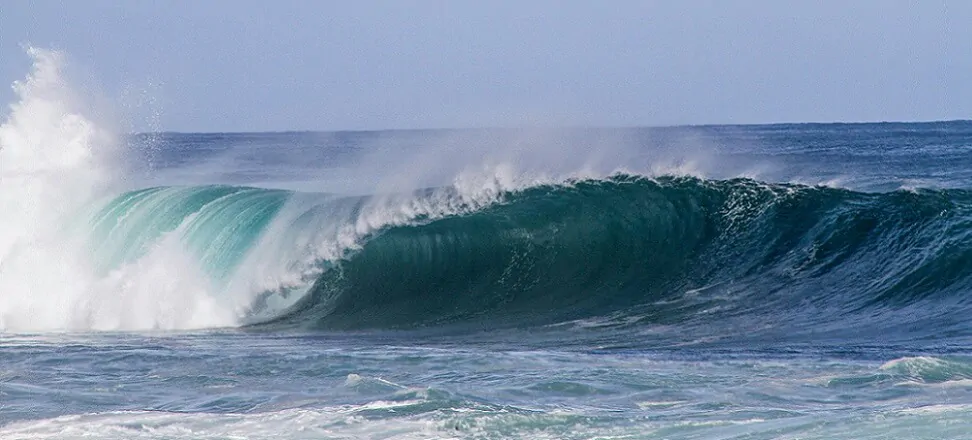From the world, In this issue, Issue 15/2024
Sea and ocean water movements
Have you ever wondered what sets the oceans in motion? Imagine that they are giant, restless rivers whose waters never stop moving. They are in constant circulation, driven by a variety of natural forces. These uninterrupted flows shape everything from climate to marine life, creating intricate and complex systems. In this article, we’ll take a look at how currents, waves and tides affect the oceans and the impact they have on the entire planet.
Seawater movements
The movement of water is a complex and dynamic process that is influenced by many factors, such as wind, temperature, salinity and density, Earth’s rotation and the shape of the bottom of ocean basins. In addition, they are also affected by external forces, such as the sun and the moon. The main movements of ocean water can be classified into three categories: waves, tides and ocean currents. Waves and currents are horizontal movements, while tides are a type of vertical movement of ocean waters.
Sea waves
Sea waves are oscillatory movements of the water surface that cause it to rise and fall. The main cause of their formation is the wind, which transmits energy to the water surface, creating waves of different lengths and heights. Depending on the strength, the time of its action and the distance traveled by the wave, different types of them can be formed – from small wrinkles on the water to giant waves.
In a wave, each water molecule moves in a circular trajectory, and the form itself consists of two main parts: the ridge, the highest point, and the valley, the lowest.
Tsunamis are a special type of wave, caused by underwater earthquakes, volcanic eruptions or landslides. Unlike wind waves, they are characterized by very long lengths and can travel at considerable speed over great distances, causing damage to coastlines.
Floats
Tides are regular, periodic rises and falls of ocean water levels, caused mainly by the gravitational forces of the Moon and Sun. These forces cause water in the oceans to move toward these celestial bodies, increasing the level (tide) or decreasing it (tide).
The process is complex and depends on many factors, such as geographic location, the shape of the coastline and the depth of the water. The height and timing of tides can vary, leading to different types of tides in different places on Earth. For example, some regions may have semi-diurnal tides, where we have two high tides and two low tides during a lunar day, while others may be dominated by one-day tides, where there is one high tide and one low tide in a 24-hour period.
The highest tides, called syzygy, occur when the Sun, Moon and Earth are aligned, which happens during full and new moons. At these times, the gravitational forces of the Moon and Sun add up, creating higher tides and lower tides. In contrast, the lowest tides, called quadrature tides, occur when the Moon and Sun form a right angle to the Earth, which occurs during the first and third quarters of the Moon. In this case, gravitational forces partially cancel each other out, leading to smaller water level amplitudes.
Tides play a key role in shaping coastlines, affecting erosion, sediment transport and the formation of beaches, bays and estuaries. They also affect marine ecosystems, including fish migration, the distribution of coastal vegetation and the functioning of wetlands and lagoons. Marine organisms such as crabs, clams and wading birds adapt their behavior to the rhythm of the tides, taking advantage of periodic access to food and shelter.
Tides also have economic and social importance. For many coastal communities, they are an important factor in fishing, maritime transportation and tourism. In some regions of the world, such as the Bay of Fundy in Canada, which has some of the highest tides in the world, the phenomenon attracts tourists and is a tourist attraction.
Also worth mentioning is the use of tidal energy. Tidal power plants, which convert the kinetic energy of water movement into electricity, are among the suppliers of renewable energy. Although the technology is still in the development stage, it has the potential to play a more prominent role in the future.
Ocean currents
Ocean currents are horizontal flows of water masses that transport heat, nutrients and organisms over long distances. These movements are driven by wind, differences in water temperature and salinity, and phenomena such as the Earth’s rotation and the force of gravity. They play a key role in climate regulation, affecting weather patterns and marine ecosystems. We can distinguish between warm and cold currents.
Warm ocean currents, flowing from equatorial areas toward the poles, are characterized by higher temperatures than their surroundings. They bring warm waters to colder regions, occurring mainly on the eastern coasts of the continents, in the lower and middle latitudes of both hemispheres. In the northern hemisphere, they also occur on the western coasts of the continents at higher latitudes, such as the Alaskan and Norwegian Currents.
Cold ocean currents, flowing from the polar regions toward the equator, carry cold water to warmer areas. They are usually found on the western coasts of the continents, in the low and middle latitudes of both hemispheres. In the northern hemisphere, they are also found on the eastern coasts at higher latitudes, such as the Labrador, East Greenland and Oja Siwo currents.
Ocean currents can also be divided into surface and deep-sea currents. Surface currents, as the name implies, flow near the surface and are driven by the wind, which moves water masses through the force of friction. Deep-sea currents occur deep below the surface. They are not directly influenced by the wind – they are created by density differences related to the temperature and salinity of seawater.
Water movements in the context of climate
The movement of ocean water plays a key role in Earth’s climate system. Ocean currents transport heat and energy over vast distances, shaping global weather patterns, temperatures and precipitation. These processes regulate climate, affecting atmospheric conditions both at sea and on land. Phenomena associated with cyclical changes in ocean temperatures can cause extreme weather conditions, underscoring the importance of water movement in global climate regulation. Understanding these processes is key to predicting them in the future, managing marine resources and protecting the environment.
Photo. main: Jeremy Bishop/Unsplash

 Polski
Polski







